Abstract
OVERVIEW: The Veterans Administration (VA) Computerized Patient Record System (CPRS) is a nationally deployed software product that integrates provider order entry, progress notes, vitals, consults, discharge summaries, problem lists, medications, labs, radiology, transcribed documents, study reports, and clinical reminders. Users rapidly adopted the graphical user interface for data retrieval, but demanded options to typing for data entry. We programmed "point and click" forms that integrate with CPRS individually, but were soon overwhelmed by requests. Subsequently, we developed the Progress Note Construction Set (PNCS); a tool suite that permits subject matter experts without programming skills to create reusable "point and click" forms. In this study, we evaluate the usability of these user-constructed forms. METHODS: An untrained, non-VA subject matter expert used the PNCS to create a graphical form for "skin tear" documentation. Ten VA nurses used the skin tear form to document findings for 7 standardized clinical scenarios. Following each scenario the subjects answered usability questions about the form. RESULTS: The subject matter expert created the skin tear form in 78 minutes. Users found the form to facilitate their data entry (p 0.0265), and to be at least as fast (p 0.0029) and as easy to use as expected (p 0.0166). Average note entry time was 3.4 minutes. CONCLUSION: The PNCS allowed a non-programmer to quickly create a usable, CPRS-integrated point and click form. Users found the subject matter expert s form fast and easy to use. The tool suite is a more scaleable form creation method because capacity is no longer limited by programmer availability.
Full text
PDF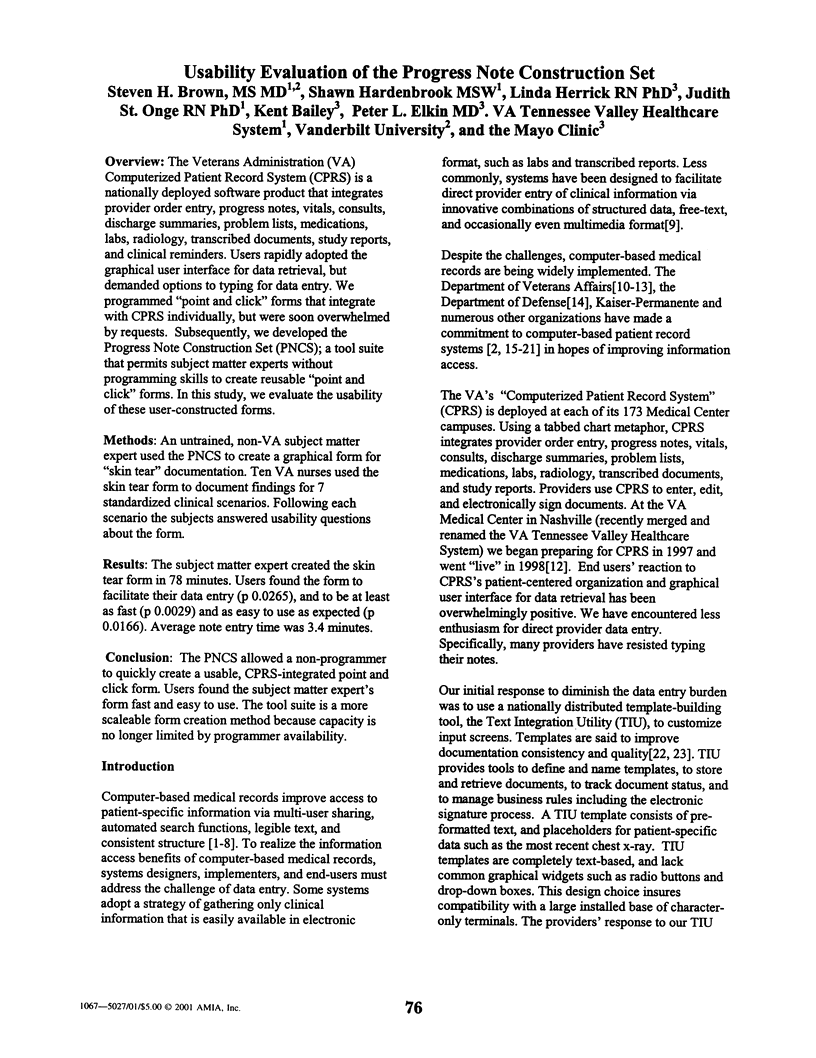
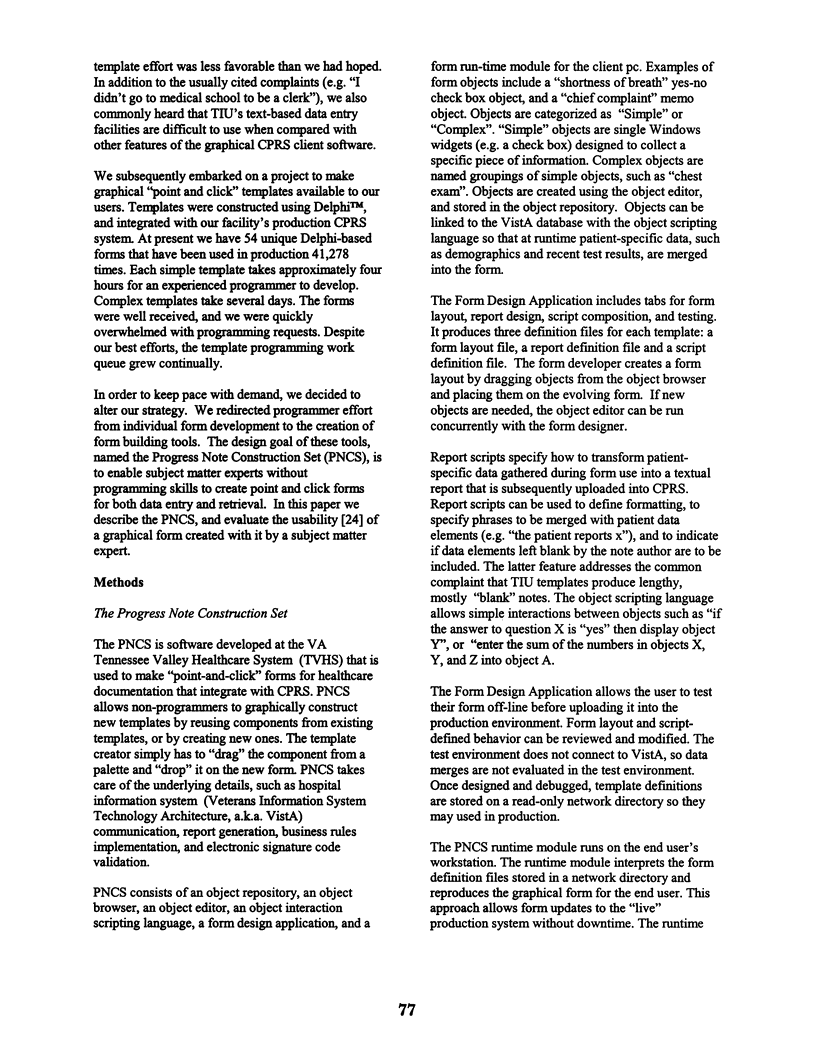
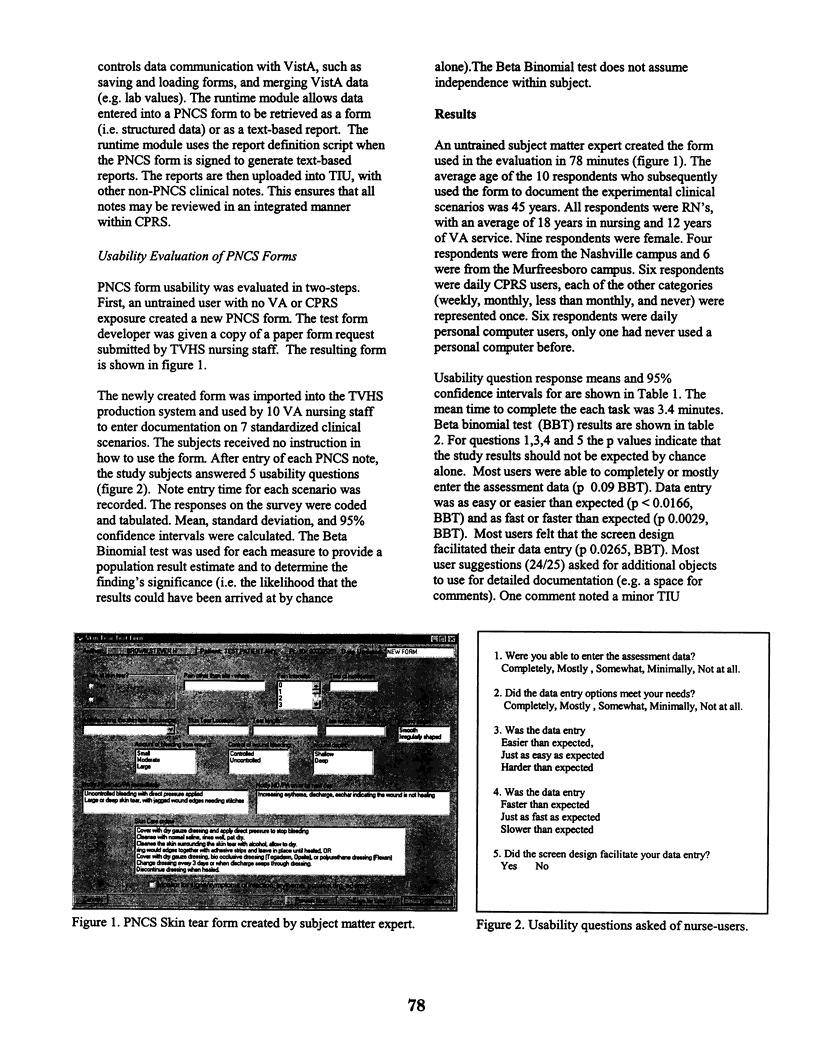
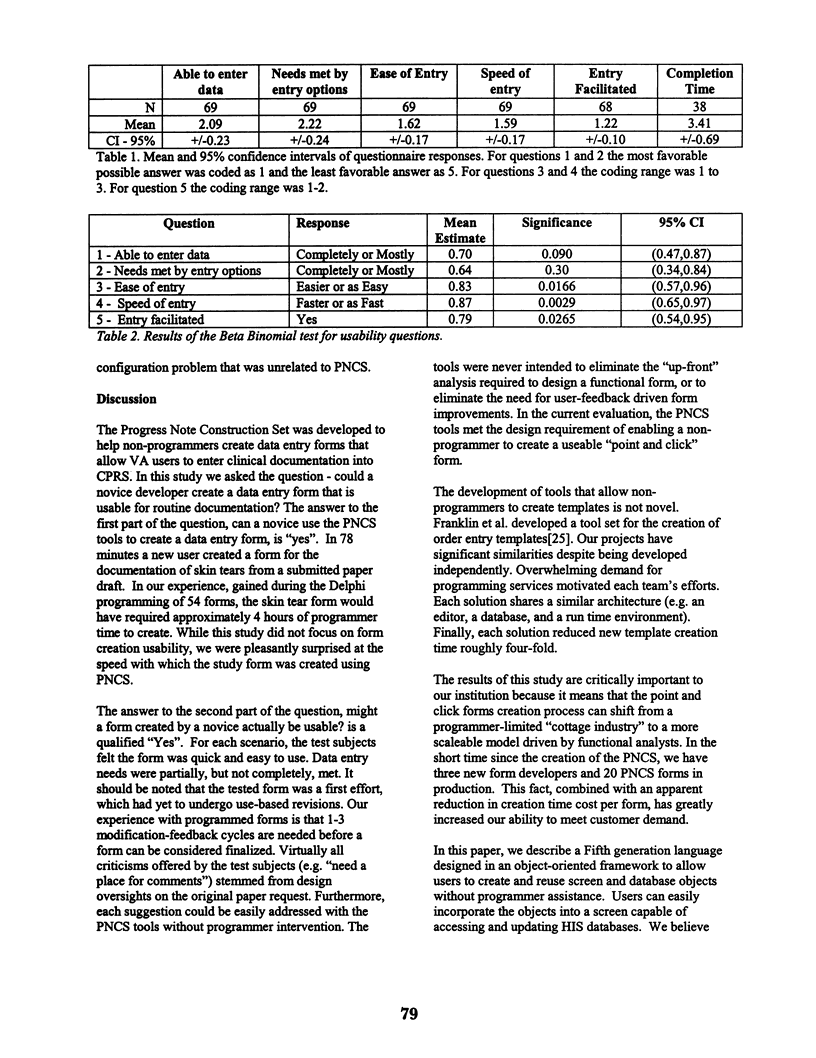
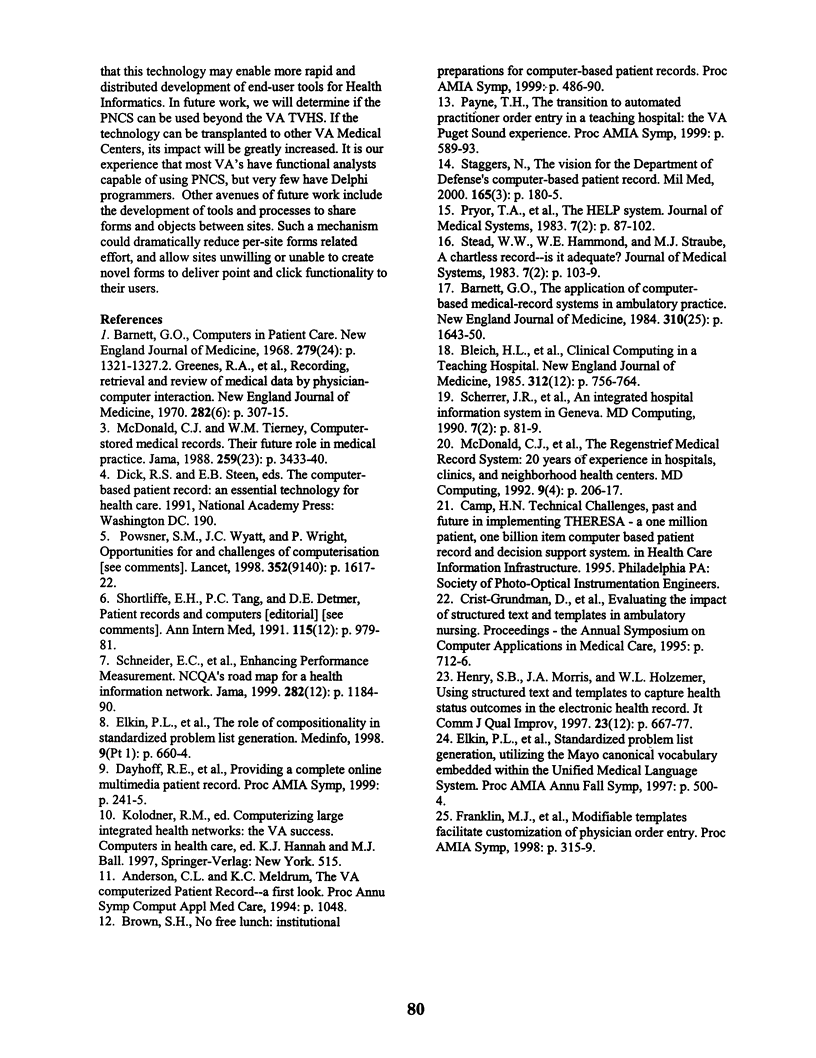
Selected References
These references are in PubMed. This may not be the complete list of references from this article.
- Anderson C. L., Meldrum K. C. The VA computerized Patient Record--a first look. Proc Annu Symp Comput Appl Med Care. 1994:1048–1048. [PMC free article] [PubMed] [Google Scholar]
- Barnett G. O. Computers in patient care. N Engl J Med. 1968 Dec 12;279(24):1321–1327. doi: 10.1056/NEJM196812122792407. [DOI] [PubMed] [Google Scholar]
- Barnett G. O. The application of computer-based medical-record systems in ambulatory practice. N Engl J Med. 1984 Jun 21;310(25):1643–1650. doi: 10.1056/NEJM198406213102506. [DOI] [PubMed] [Google Scholar]
- Bleich H. L., Beckley R. F., Horowitz G. L., Jackson J. D., Moody E. S., Franklin C., Goodman S. R., McKay M. W., Pope R. A., Walden T. Clinical computing in a teaching hospital. N Engl J Med. 1985 Mar 21;312(12):756–764. doi: 10.1056/NEJM198503213121205. [DOI] [PubMed] [Google Scholar]
- Brown S. H. No free lunch: institutional preparations for computer-based patient records. Proc AMIA Symp. 1999:486–490. [PMC free article] [PubMed] [Google Scholar]
- Dayhoff R. E., Kuzmak P. M., Kirin G., Frank S. Providing a complete online multimedia patient record. Proc AMIA Symp. 1999:241–245. [PMC free article] [PubMed] [Google Scholar]
- Elkin P. L., Mohr D. N., Tuttle M. S., Cole W. G., Atkin G. E., Keck K., Fisk T. B., Kaihoi B. H., Lee K. E., Higgins M. C. Standardized problem list generation, utilizing the Mayo canonical vocabulary embedded within the Unified Medical Language System. Proc AMIA Annu Fall Symp. 1997:500–504. [PMC free article] [PubMed] [Google Scholar]
- Elkin P. L., Tuttle M., Keck K., Campbell K., Atkin G., Chute C. G. The role of compositionality in standardized problem list generation. Stud Health Technol Inform. 1998;52(Pt 1):660–664. [PubMed] [Google Scholar]
- Franklin M. J., Sittig D. F., Schmiz J. L., Spurr C. D., Thomas D., O'Connell E. M., Teich J. M. Modifiable templates facilitate customization of physician order entry. Proc AMIA Symp. 1998:315–319. [PMC free article] [PubMed] [Google Scholar]
- Greenes R. A., Barnett G. O., Klein S. W., Robbins A., Prior R. E. Recording, retrieval and review of medical data by physician-computer interaction. N Engl J Med. 1970 Feb 5;282(6):307–315. doi: 10.1056/NEJM197002052820605. [DOI] [PubMed] [Google Scholar]
- Henry S. B., Morris J. A., Holzemer W. L. Using structured text and templates to capture health status outcomes in the electronic health record. Jt Comm J Qual Improv. 1997 Dec;23(12):667–677. doi: 10.1016/s1070-3241(16)30348-0. [DOI] [PubMed] [Google Scholar]
- McDonald C. J., Tierney W. M. Computer-stored medical records. Their future role in medical practice. JAMA. 1988 Jun 17;259(23):3433–3440. [PubMed] [Google Scholar]
- McDonald C. J., Tierney W. M., Overhage J. M., Martin D. K., Wilson G. A. The Regenstrief Medical Record System: 20 years of experience in hospitals, clinics, and neighborhood health centers. MD Comput. 1992 Jul-Aug;9(4):206–217. [PubMed] [Google Scholar]
- Payne T. H. The transition to automated practitioner order entry in a teaching hospital: the VA Puget Sound experience. Proc AMIA Symp. 1999:589–593. [PMC free article] [PubMed] [Google Scholar]
- Powsner S. M., Wyatt J. C., Wright P. Opportunities for and challenges of computerisation. Lancet. 1998 Nov 14;352(9140):1617–1622. doi: 10.1016/S0140-6736(98)08309-3. [DOI] [PubMed] [Google Scholar]
- Pryor T. A., Gardner R. M., Clayton P. D., Warner H. R. The HELP system. J Med Syst. 1983 Apr;7(2):87–102. doi: 10.1007/BF00995116. [DOI] [PubMed] [Google Scholar]
- Schneider E. C., Riehl V., Courte-Wienecke S., Eddy D. M., Sennett C. Enhancing performance measurement: NCQA's road map for a health information framework. National Committee for Quality Assurance. JAMA. 1999 Sep 22;282(12):1184–1190. doi: 10.1001/jama.282.12.1184. [DOI] [PubMed] [Google Scholar]
- Shortliffe E. H., Tang P. C., Detmer D. E. Patient records and computers. Ann Intern Med. 1991 Dec 15;115(12):979–981. doi: 10.7326/0003-4819-115-12-979. [DOI] [PubMed] [Google Scholar]
- Staggers N. The vision for the Department of Defense's computer-based patient record. Mil Med. 2000 Mar;165(3):180–185. [PubMed] [Google Scholar]
- Stead W. W., Hammond W. E., Straube M. J. A chartless record--is it adequate? J Med Syst. 1983 Apr;7(2):103–109. doi: 10.1007/BF00995117. [DOI] [PubMed] [Google Scholar]


